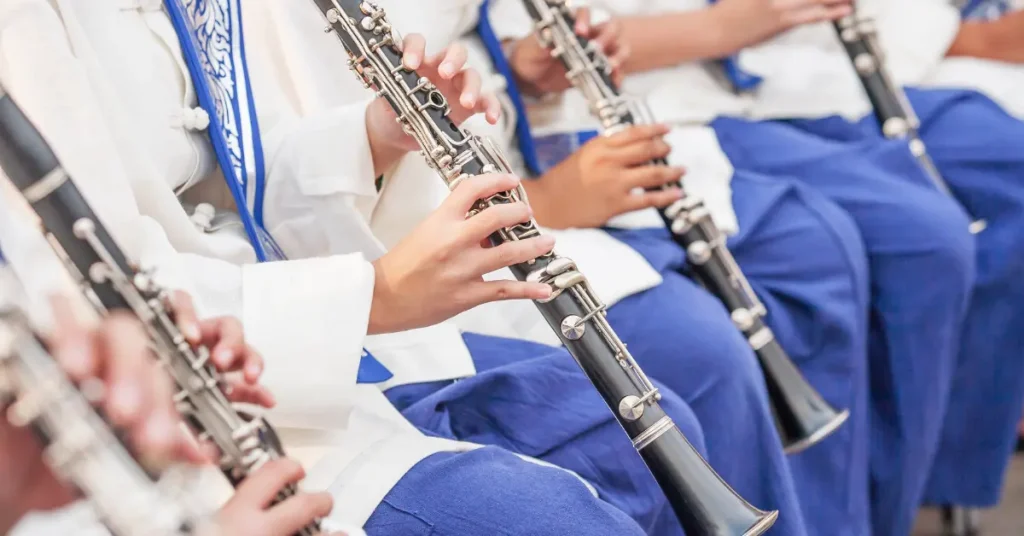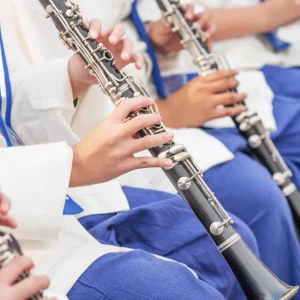Have you ever caught yourself tapping your toes to the thrilling rhythm of instruments in a marching band? You know, that irresistible pull when brass and percussion marry in a spectacle of sound and movement. Imagine the air vibrating with energy as trumpets blare their high-energy calls, trombones slide through melodies with finesse, and tubas rumble like distant thunder.
But what about those instruments you can’t quite name? The ones weaving threads of melody so deftly they become part of your heartbeat? From flutes that slice clean through the thickest air to clarinets that weave harmonious spells among saxophones’ jazzy whispers.
In this guide, we’ll discuss the instruments in a marching band. Plus we’ll give you tips on how to play these instruments with resources and practice techniques.
If you’re looking to pick up one of these instruments or need accessories to enhance your play, explore our shop page.
Key Takeaways:
- Instrument Diversity: Highlights the variety of instruments in a marching band, emphasizing their unique roles and sounds, from brass to woodwinds.
- Instrument Features: Describes the distinct characteristics of instruments like the commanding trumpets and foundational tubas.
- Practical Learning Tips: Offers practical advice for beginners, including regular practice routines and proper instrument care.
- Motivational Guidance: Encourages participation in marching bands and provides motivational tips for learning and improving musical skills.
- Cultural Significance: Underlines the emotional and cultural importance of marching bands in public events and community gatherings.
The Brass Instruments in a Marching Band
The brass section in a marching band is like the engine room of a battleship—powerful, loud, and utterly indispensable. When these musicians fire up their instruments, you can bet everyone sits up and takes notice.
The Trumpet
Step aside for the trumpet—the high-octane frontman of any brass ensemble. These shiny heralds are notorious for cutting through even the thickest wall of sound with their piercing clarity. With an outgoing personality that resonates from its bell, trumpets bring a distinctive sound that screams ‘listen to me.’
A staple at every football game or parade, it’s hard not to get swept away by multiple trumpets belting out tunes with an almost electric charge in the air—a testament to their role as leaders within marching bands. Trumpeters aren’t just blowing hot air; they’re blasting out signals for all other members to follow suit.
If you’re looking to join this high-energy troupe, remember: practice makes perfect. Start small with scales and arpeggios before tackling those fanfares that’ll have people cheering your name—or at least tapping their feet.
The Trombone
The trombone isn’t just another brass instrument—it’s got swagger thanks to its unique slide mechanism allowing it unrivaled expression among its peers. Think about sliding into a home base—that’s what playing the trombone feels like but musically speaking.
This big guy might seem intimidating because of its larger bell and longer reach needed for notes—but don’t be fooled; it has one heck of a mellower sound than most expect from something so grand-looking. Trombones often add depth when they feature multiple counterparts in formations echoing each other’s parts—an auditory dance if ever there was one.
The Tuba
You can think of tubas as gentle giants whispering secrets amidst thunderous roars across football fields everywhere—they provide those rich undertones forming marching music’s very backbone while still being able to dish out melody lines when called upon as well.
Possessing deep bass sounds that resonate through your bones, these bass-brass behemoths may look tough with their large size, but believe me when I say they’ve got hearts—and lungs. They can belt out tunes with a warmth and richness that speaks to the soul.
Tips For Learning To Play Brass Instruments
1. Master Proper Breathing Techniques
The foundation of playing any brass instrument is good breath control. Practice deep breathing exercises to increase lung capacity and learn to control your breath. Remember, breathe from your diaphragm, not just your chest.
2. Embouchure Development
Your embouchure, which is how you shape your mouth on the mouthpiece, is critical. Work on developing a strong, consistent embouchure. This can involve exercises like buzzing your lips without the instrument and practicing with just the mouthpiece.
3. Regular Practice is Key
Consistency is key. Even short, daily practice sessions are better than infrequent, longer ones. This helps in building muscle memory and improving your skills gradually.
4. Start with Simple Notes and Scales
Begin with basic notes and scales before moving on to more complex pieces. This helps in understanding the instrument and in developing a sense of pitch and tone.
5. Proper Instrument Care
Brass instruments require regular maintenance. Learn how to properly clean and care for your instrument to keep it in good playing condition.
6. Use a Tuner and Metronome
A tuner will help you stay in pitch while a metronome will help you keep time. These tools are essential for developing good musical habits.
7. Listen to Professional Musicians
Listening to skilled brass players can be inspirational and educational. Try to understand their techniques and styles.
8. Get Feedback from your Teacher
Get lessons or feedback from a more experienced player or teacher. They can provide valuable insights and help correct any bad habits early on.
9. Patience and Persistence
Learning an instrument takes time and effort. Be patient with yourself and persistent in your practice.
10. Enjoy the Learning Process
Finally, remember to have fun. Enjoy the process of learning and making music.
These tips should set you on the right path to becoming a proficient brass player. Remember, the journey of learning an instrument is as rewarding as the outcome. Happy practicing!
The Woodwind Instruments
The vibrant tapestry of a marching band’s sound owes much to the woodwind section. Here, instruments like the piccolo flute and clarinet don’t just play notes; they weave stories in the air. The saxophone adds its jazzy undertones, turning every performance into a rhythmic narrative that captivates audiences.
The Flute & Piccolo
When it comes to high-pitched melodies that float above an ensemble like butterflies over a field, flutes, and their smaller cousins, piccolos, steal the show. Not only are these instruments lightweight and easy to carry, but they also possess lyrical voices that gracefully navigate intricate arrangements. Their agility and brightness make them perfect for school bands aiming to captivate audiences from bleachers or parade routes.
If you’ve ever felt your heart lift during a particularly spirited tune at halftime shows or festive parades, chances are you were riding on the wings of these woodwinds’ soaring sounds. It’s no surprise why flutes and piccolos provide those unforgettable high-pitched melodies—they’re built for it.
The Clarinet
In contrast to its higher-octave relatives is the clarinet—a harmonious voice among winds whose middle register brings warmth where others sparkle. With distinctive unison sounds often shadowing flutes or blending seamlessly within sections including saxophones as well, marching bands rely on this versatile instrument.
Its chameleon-like ability allows it not only to play melody but also supporting roles in intricate musical weaves—the glue holding together many pieces’ melodic structure while adding depth and color.
Musicians who choose clarinets do so knowing they hold keys (pun intended) capable of unlocking richer layers within each song—an act akin to painting strokes on canvas contributing both detail and harmony simultaneously.
Tips For Learning To Play Woodwind Instruments
Learning to play a woodwind instrument is an exciting journey that requires dedication, practice, and a bit of patience. Here are some tips to help beginners navigate this learning process effectively:
1. Develop a Good Embouchure
For woodwind players, the embouchure (how you shape your mouth on the instrument’s mouthpiece) is crucial. Focus on developing a consistent, firm embouchure that allows you to produce clear, stable tones.
2. Breathing Techniques
Proper breath control is essential. Practice taking deep breaths from your diaphragm, and learn to control your breath to support a steady airflow. This is key to maintaining tone and pitch.
3. Consistent Practice
Regular practice is vital. Aim for short, focused practice sessions daily rather than occasional longer sessions. Consistency helps build muscle memory and improves your skills more efficiently.
4. Start with Basic Scales and Simple Pieces
Begin with simple scales and easy pieces to get a feel for the instrument. This helps in building a solid foundation in terms of finger positioning, breath control, and rhythm.
5. Instrument Care and Maintenance
Woodwind instruments require careful maintenance. Learn how to properly clean and store your instrument to keep it in optimal playing condition.
6. Use a Metronome
A metronome is a valuable tool for keeping time. Practicing with a metronome helps develop a sense of rhythm and timing, which is essential for playing woodwind instruments.
7. Listen to Professional Players
Listen to skilled woodwind musicians to understand different styles and techniques. This can be highly inspiring and informative.
8. Finger Technique and Posture
Pay attention to your finger technique and overall posture. Good posture and correct finger positioning improve your playing and prevent strain or injury.
By following these tips and dedicating yourself to regular practice, you’ll be on your way to becoming a proficient woodwind player.
The Percussion Instruments
Rhythm isn’t merely kept by percussion instruments—it’s owned by them. Marching bands possess a formidable array: snare drums issue crisp orders in the air; bass drums resonate with deep beats beneath feet, setting rhythmic pulses; tenor drums provide melodic hues amidst percussive waves crashing against the music-filled shores of stadiums worldwide.
The Tenor Drums
Tenor drummers are artists—no ifs or beats about it. They paint rhythm across canvases of time using sticks instead of brushes, yet produce artwork all the same. This is particularly true when considering the unique tonal colors they add to a blend that might otherwise have seemed monochromatic.
The Snare Drum
The snare drum is like your punctual friend who always shows up on time and with style—essential for setting the tempo. Imagine this: sticks flying at lightning speed as each crack resonates perfectly with military precision. It’s no wonder snares are crucial for beat-keeping in every single parade or halftime show out there.
Surely everyone recognizes its rat-a-tat rallying cry from classic movie scenes featuring an army marching into battle—it’s iconic. And let me tell ya, when it comes to making sure everyone steps right-left-right together, nothing does it better than a good ol’ snare drum leading the charge.
The Bass Drum
You feel it before you see it—the deep bass sounds from these big daddies hit right in your chest and echo down your spine. Bass drums aren’t just large; their impact is colossal too. Each thump lays down a foundational rumble that glues all other sounds together in perfect harmony while adding dramatic depth to music scores tailor-made for those thrilling field maneuvers we love so much.
Band members carrying them look like warriors shouldering shields as they march forward, unfazed by their instrument’s size because hey—when has awesome ever been easy to carry?
Tips For Learning To Play Percussion Instruments
Learning to play a percussion instrument can be a dynamic and exciting experience. Here’s some useful tips for beginners embarking on this musical journey:
1. Understand the Basics of Rhythm and Timing
As a percussionist, your primary role is to maintain rhythm and timing. Start by understanding basic rhythms and time signatures. Practice clapping or tapping these rhythms to internalize them.
2. Develop Good Stick Technique
Whether you’re playing drums or a mallet instrument, proper stick technique is crucial. Learn the correct way to hold sticks or mallets and practice various strokes and grips to develop control and flexibility.
3. Start with Basic Beats and Patterns
Begin with simple beats and patterns before progressing to more complex ones. This will help you build a solid foundation in rhythm and coordination.
4. Listen and Learn from Different Styles
Percussion is present in almost all musical styles. Listen to different genres to understand how percussion is used in various musical contexts. This will broaden your understanding and appreciation of rhythm.
5. Regular Practice
Consistent practice is key to improving your skills. Aim for regular, focused practice sessions. Even short daily sessions are more effective than infrequent long ones.
6. Learn to Read Music
While some percussion instruments don’t require reading traditional music notation, understanding rhythm notation is very beneficial. This skill will allow you to learn and play more complex pieces.
7. Develop Your Listening Skills
Good percussionists are not just skilled players, but also attentive listeners. Pay attention to the music as a whole and understand how your playing fits within the ensemble.
8. Work on Coordination and Independence
Many percussion instruments require a high level of coordination and limb independence. Practice exercises that challenge you to use your hands and feet independently.
9. Play Along with Music
Playing along with recordings can be a fun and effective way to practice. It helps you learn how to keep time with other musicians and enhances your musicality.
A Final Word on Marching Band Instruments
Instruments in a marching band bring life to parades and games, each instrument playing its part. Brass bellows with vigor; woodwinds weave melodies; percussion drives the rhythm forward. Together, they create a symphony on the move.
Trumpets aren’t just loud—they’re leaders, setting the tone with every high-energy note. Trombones follow suit, their slides painting broad musical strokes that captivate listeners.
Tubas are your anchors in this sonic sea of marching band instruments—never underestimate their deep hum that steadies all other sounds. And for practicality paired with power? The sousaphone’s coil wrap design has it covered.
The flutes and piccolos are light as feathers but sharp enough to cut through any ensemble buzz. Clarinets join in harmony while saxophones add that cool touch only they can give. If you’re interested in learning any of these instruments or in an instrument rental, contact Sloan School of Music.











